The glute ham raise is a killer way to train your hamstrings and glutes. Here’s a detailed look at this powerful exercise, including benefits, muscles worked, tips for doing them properly, and more.
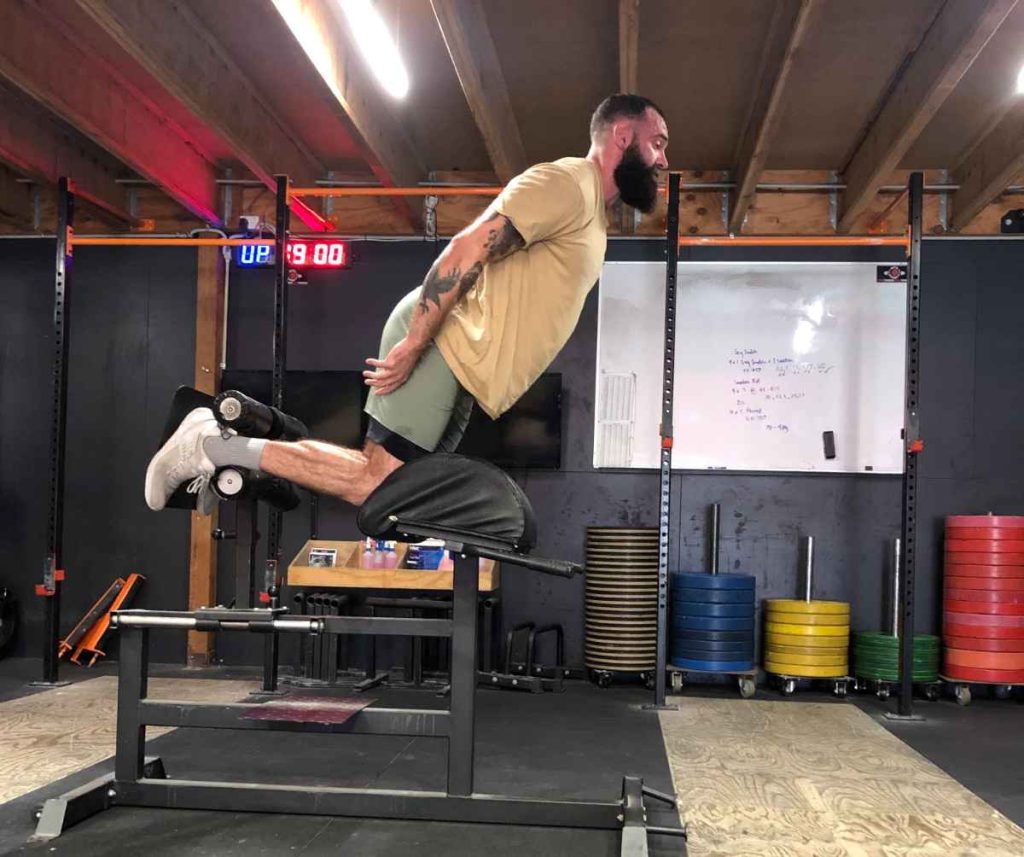
I’m often surprised that on Leg Day, many people tend to focus on the quads. I understand why: the quads are what gives your legs the size and pushing power.
But just because the quads are the bigger muscles, that doesn’t mean they’re more important. In fact, I’d argue that your glutes and hamstrings are even more important in your everyday life.
Your glutes work with your core muscles to ensure efficient lower body movement, and play a role in keeping you stable/balanced with every step you take. And your hamstrings are critical for pulling/curling your legs toward you.
It’s critical to spend time training both muscles—which is why I LOVE the glute ham raise!
In this guide, we will look at the glute ham raise from top to bottom, including an overview of the exercise, muscles worked, step-by-step instructions for doing it like a pro, and even some glute ham raise alternatives.
Let’s jump right in.
What is a Glute Ham Raise?
The glute ham raise is one of the all-time best glute and hamstring-focused exercises around. It’s truly effective at engaging both lower body muscles in a way that few other machines or free weight exercises can.
The exercise is typically machine-based—you’ll often see the glute ham raise machine standing next to the back extension machine, and they can often be confused because of how similar they are.
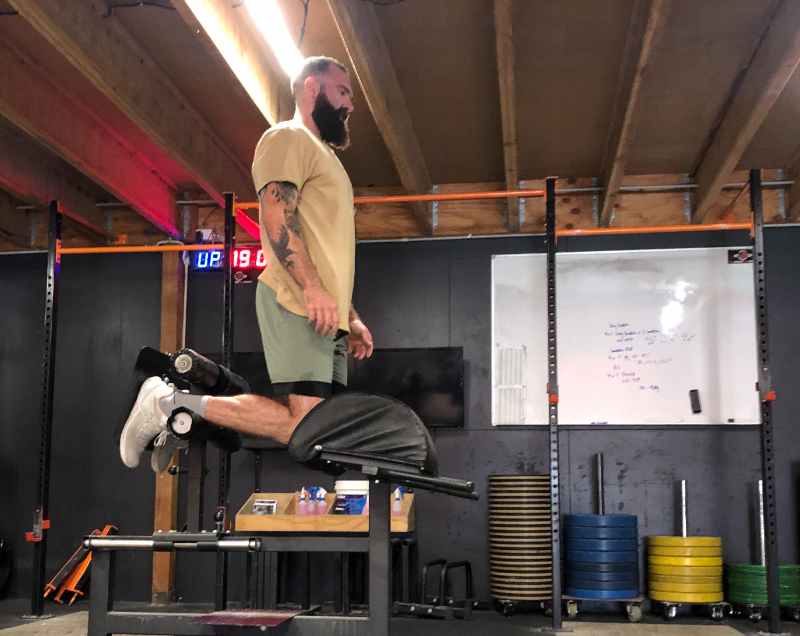
With the back extension machine, your hips are resting on the seat, so all of the focus is on your lower back. With the glute ham raise machine, however, it’s your knees/thighs that are supported, so when you bend forward (like you do with a back extension) it engages the glutes and hamstrings to lift your body back up.
Trainer’s Note
Think of them as an inversion of the hamstring curl, only instead of curling a weight by bending your legs, your legs remain stationary and it’s your entire body that curls.
Benefits of Glute Ham Raises
Why would you spend time doing glute ham raises instead of all the other glute and hamstring-focused exercises out there (like hamstring glutes, glute bridges, hip thrusters, etc.)?
Well, there are a few specific benefits that make this one of the all-time BEST exercises to target your hamstrings (and glutes!):
Double engagement in one exercise.
That’s right: this exercise works both your glutes and hamstrings at the same time.
Both muscles are needed to move your body through the full range of motion, which means that you can hit fatigue in two muscle groups at once.
That’s how you get through a workout faster and more efficiently!
Functional strength.
Because the exercise uses body weight (and the addition of free weights, if you can), it trains you for “functional strength”—also known as the power needed to move your own body weight.
This will enable more efficient movement in every aspect of your life, and you’ll find yourself stronger every time you run, jump, crawl, climb, squat, and lunge.
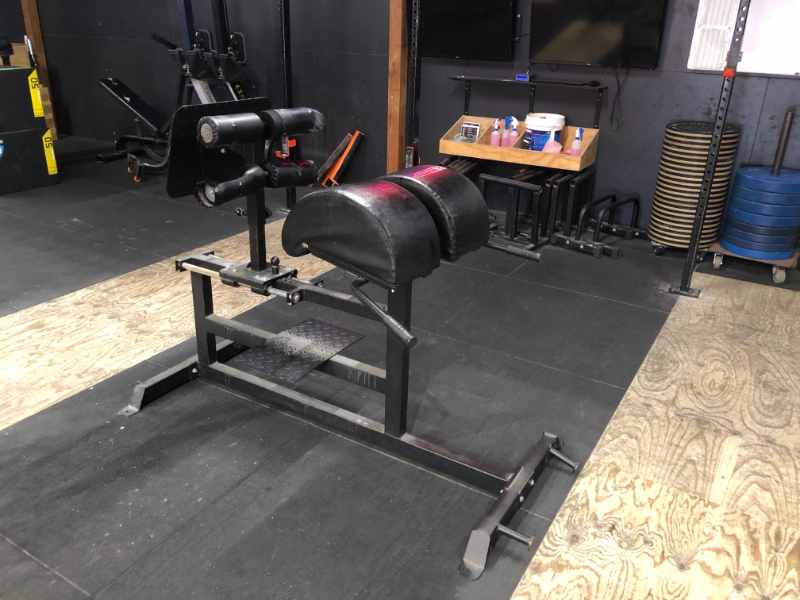
Better performance in other heavy lifts.
Spending time working out your glutes and hamstrings with the glute ham raise will translate into greater power for other important, heavy lifts, like the deadlift, good morning, stiff-legged deadlift, Romanian deadlift, even squats.
Though your glutes and hamstrings aren’t the prime movers in all of these lifts, they play critical support roles and maintain stability/balance.
Strengthening them will help to increase your overall power and strength in these other lifts.
Excellent for your lower back.
Your hamstrings and glutes both help to support your lower back (part of the posterior chain) in pretty much every movement.
In fact, insufficient strength or mobility in your glutes and hamstrings can contribute to a higher risk of lower back injuries because your back has to compensate for a lack of power or flexibility in your lower body.
Not only does the glute ham raise help to strengthen the two muscles that work to support your lower back, but it even engages your lower back itself to increase core strength and bracing power.
Improve your posture.
Posture isn’t just about keeping your head up and shoulders back; your lower body also plays a role in your posture.
Your glutes and hamstrings help your lower back to keep your torso upright, bearing the weight of whatever you’re carrying or holding in your arms.
Spending time targeting these lower body muscles will do wonders to improve your posture.
What Muscles Do Glute Ham Raises Work?
The prime movers of the glute ham raise are, as the name suggests, the glutes and hamstrings.
- When you’re in your starting position (thighs resting on the pad), your hamstrings engage to uncurl your body forward (at the knees). Your glutes work with the hamstrings to enable smooth bending, with more focus placed on the gluteal muscles at the lowest point of the exercise.
- In order to pull back up (the “raise” part of the exercise), your hamstrings have to engage to curl the legs inward, and your glutes work to start lifting your upper body.
Both muscles are utilized fully through the entire range of motion, making it the single most effective exercise to train both your glutes and hamstrings.
In addition, the exercise also brings in some other muscles, including:
- Lower back (spinal erectors)
- Calves
How to Do the Glute Ham Raise Like a Pro
Time to get to work and do this exercise right!
The glute ham raise is far from the easiest exercise to do—it requires you to have sufficient strength to lift your bodyweight—but it is beautifully simple.
As long as you follow the steps below and maintain the proper form (as I explain it), you’ll be on the right track to mastering the glute ham raise in no time.
To perform this exercise:
Step 1: Set up like a champ.
To start, set the glute ham raise machine to the right settings according to your height.
You want to set it so your feet will be planted against the toe plate, with the pad placed directly beneath your mid-thighs (quads).
Trainer’s Note
Avoid placing your knees at the top of the pad, as this can increase the risk of knee hyperextension and shift the focus away from your hamstrings/glutes.
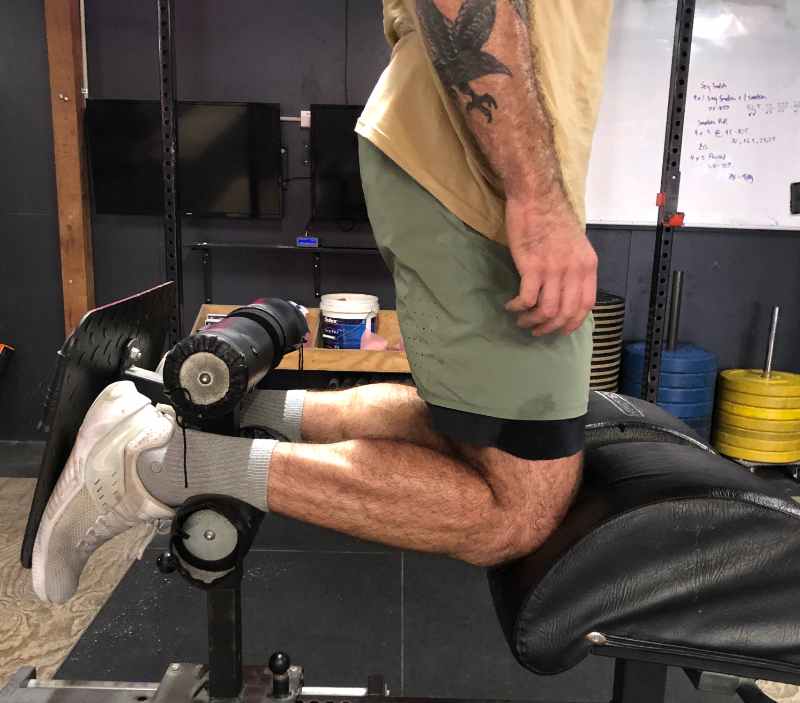
Step 2: Assume the position.
Get into position on the machine, with your feet firmly planted and your thighs resting on the pads. Extend your knees and bend forward until your torso is parallel to the floor.
Make sure to keep your hands at your side, behind your head, or crossed in front of your chest.
Step 3: Bend forward.
Start off by bending forward at the waist, lowering your head toward the floor. (Don’t worry, the machine is high enough that it won’t touch!)
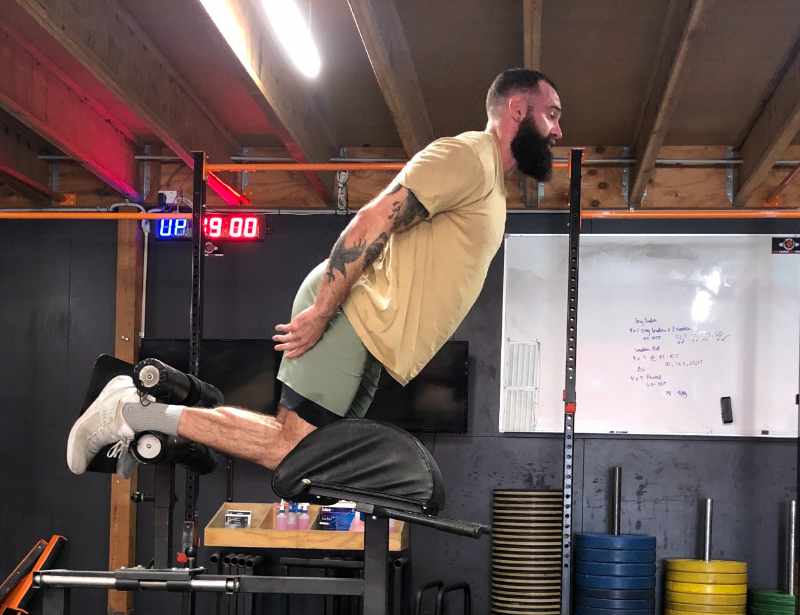
Don’t lower too far, though. You want to keep all the tension on your hamstrings and glutes. The farther down you go, the more your lower back will engage.
Trainer’s Note
At all costs, avoid rounding in your lower back. Keep that spine straight and stiff in order to maximize glute/hamstring engagement.
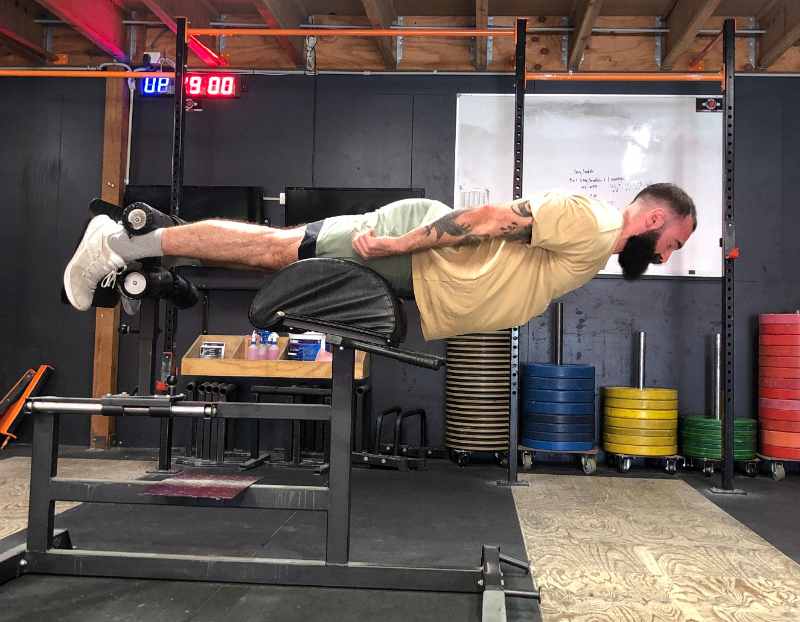
Step 4: Lift.
Drive the balls of your feet into the toe plate as you engage your hamstrings and glutes to lift your body up to a near-vertical position.
Step 5: Repeat as desired.
You’ll find that your glutes and hamstrings initially tire quickly, so try to work in the 5-8 rep range for the first few attempts.
Once you master it, you can increase to 10-12 reps, and start adding more weight (by holding a weight disc or medicine ball to your chest) as your strength increases.
What Are Some Good Glute Ham Raise Alternatives?
Want to master the glute ham raise but don’t quite have enough strength to lift your bodyweight?
Don’t sweat it!
Here are three alternatives you can try that will help you gain power in your glutes and hamstrings and help you work up to the glute ham raise:
Good Mornings
This exercise works your body through a very similar range of motion as the glute ham raise, with maximum focus on your hamstrings, glutes, and lower back.
By adding the weight onto your shoulders, you train your posterior chain muscles in that lifting motion that’s critical for knocking out multiple sets of glute ham raises.
Nordic Hamstring Curl
This exercise is one you can do at home or at the gym, using nothing but a barbell and a thick, padded mat to cushion your knees.
It works exactly the same as a glute ham raise, as you lower your upper body to the ground with the weight of a barbell providing the same stability as the glute ham raise machine.
Hip Thrusters
This exercise works the glutes and hamstrings to build that leg-curling power you need to develop to achieve success in the glute ham raise.
It’s also amazing for increasing hip/lower body mobility and correcting postural imbalances.
We’ve written extensively on hip thrusts, including articles on muscles worked with hip thrusts, best hip thrust machines, benefits of hip thrusts, and a comparison of hip thrusts vs. glute bridges.
Glute ham gliders
Glute ham gliders or rollers are a simple yet powerful little piece of strength training equipment that places a ton of recruitment on the muscles in the glutes and hamstrings.
They simulate a hamstring curl, but are done on your back and require your core muscles to work overtime to stabilize and control the roller as you move it away from the body.
Glute Ham Raise FAQs
Is a glute ham raise a hinge movement?
The glute ham raise is half a hinge movement, half a curl movement. With back hyperextensions, you hinge at the hips to raise/lower your upper body.
The glute ham raise, however, only involves minor hinging at the hips and knees. Most of the work is done by your hamstrings and glutes contracting to “curl” your body upward.
Can glute-ham raise replace deadlift?
The standard deadlift is all about hitting those back muscles (chiefly the lats and traps, with some lower back engagement), though your glutes and hamstrings do a lot of the work.
Stiff-legged deadlifts, on the other hand, are more glute/hamstring-focused. You can use glute ham raises to replace stiff-legged deadlifts in your Leg Day workout, but you’ll still want to keep regular deadlifts on Back Day.
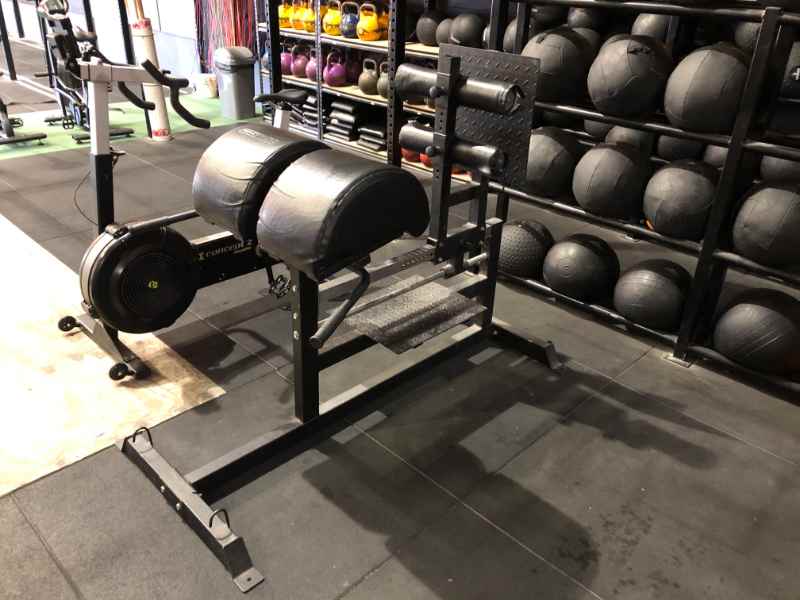
Are glute ham raises safe?
There is a risk that your bodyweight will be too much for your hamstrings to handle, which could lead to pulled or strained hamstring muscles.
If your posture is incorrect, you may feel the strain elsewhere—typically in your knees and calves if the pad is placed too low.
However, if done correctly using the proper form, it is as safe as any other bodyweight leg-curling exercise!
What is the difference between a Nordic curl and glute ham raise?
The Nordic curl is a floor-based exercise that utilizes a barbell to provide resistance for your feet, keeping them from lifting as you bend forward into the curl. The glute ham raise, on the other hand, utilizes a purpose-built machine that keeps your lower legs securely immobilized to keep the focus entirely on your glutes and hamstrings.
Can you do glute ham raises without a machine?
Absolutely! If you don’t have a glute ham raise machine, you can do the Nordic curl, which is the free weight variation on glute ham raises.
You’ll need a heavy barbell to weigh down your feet, a padded mat to cushion your knees, and you’re good to go!
The Bottom Line
The glute ham raise is one of the best exercises to do if you’re trying to build raw power in your glutes and hamstrings, and it will do wonders to increase your functional strength.
Spending more time on this doubly effective exercise will ensure you can get through those squats, lunges, and deadlifts more easily.
If your gym has a glute ham raise machine, I strongly recommend you include it into your Leg Day workout.
Stronger glutes, posture, and overall posterior chain strength await!
** A special thanks to my pal Ray Hodgkinson, a CrossFit stud, Functional Fitness Coach and former National Lacrosse League player for doing the exercise demos for this write-up. Give him a follow on Instagram @RayzerBlades.
More Glute and Hamstring Guides and Articles
7 Best Glute Ham Developer Machines. GHD machines are one of the best ways to fire up and strengthen your posterior chain and midsection. Here’s a breakdown of the best glute ham developer machines for every budget and athlete.
Glute Ham Raises vs. Back Extensions: Pros, Cons and Differences. The glute ham raise and back extension are excellent exercises for hitting your posterior chain. But they differ significantly in muscles worked, injury-risk, and even accessibility. Here’s a detailed comparison including pros and cons of both.